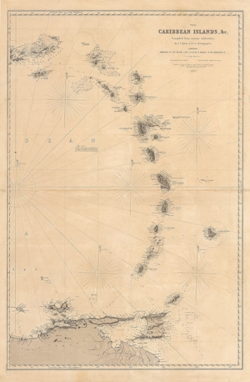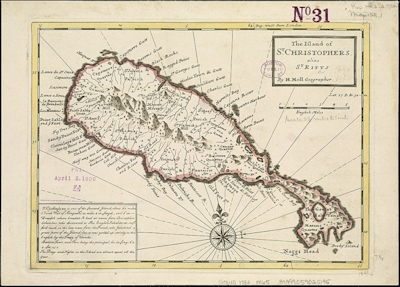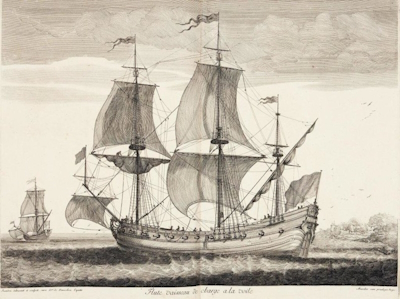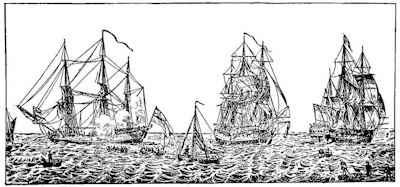 The name King William’s War was given to the American theatre of operations in the Nine Years’ War. It was probably named so because the war broke out when William III ascended to the throne of England and because of the financial interests he held in the Hudson Bay Company. It was fought on a much smaller scale than in Europe. One area of contention was the fur trade in the colonies, another was Caribbean trade. England and Spain, who were traditionally enemies in the Caribbean, were now allied against France, but although the Allies had for the most part the naval advantage in this region, it proved impossible to keep the French from supplying their colonial forces.
The name King William’s War was given to the American theatre of operations in the Nine Years’ War. It was probably named so because the war broke out when William III ascended to the throne of England and because of the financial interests he held in the Hudson Bay Company. It was fought on a much smaller scale than in Europe. One area of contention was the fur trade in the colonies, another was Caribbean trade. England and Spain, who were traditionally enemies in the Caribbean, were now allied against France, but although the Allies had for the most part the naval advantage in this region, it proved impossible to keep the French from supplying their colonial forces.
The war in the Caribbean
 At the beginning of the war French military power was superior in this region. They captured the Dutch island of St. Eustatius in April 1689 and attacked the English half of island of St. Kitts in June 1689, driving the English out. The English colonists relied heavily on militias and privateers to fight the war as it took a long time for aid from England to arrive. The Governor of the Leeward Islands requested aid from England to retake St. Kitts, which didn’t arrive until 1690. Militiamen were sent to Anguilla to relieve the population, which had been under attack by the French since November 1688, and although they weren’t able to drive off attackers they could rescue many of the besieged inhabitants. On 13th December 1689, a colonial force arrived from Nevis and Barbados took St. Barthélemy, and in January 1689 undertook a partially successful attempt to attack St. Martin, until the presence of a French fleet forced the English to withdraw. An expedition of 13 vessels carrying several hundred troops under Captain Lawrence Wright, which was to be sent from England, was delayed, not leaving Plymouth until 8th March 1690. The English force arrived in May 1690, but was hampered by disease. Captain Wright met up with Christopher Codrington, commander of the colonial forces in June, their combined force amounting to a mere 2000 men. A surprise attack on St. Kitts on 19th June was brought to a standstill by the strong French defences, but the English eventually captured it by using diversionary tactics, finally taking the island after heavy fighting. The English next recaptured St. Eustatius on behalf of the Dutch.
At the beginning of the war French military power was superior in this region. They captured the Dutch island of St. Eustatius in April 1689 and attacked the English half of island of St. Kitts in June 1689, driving the English out. The English colonists relied heavily on militias and privateers to fight the war as it took a long time for aid from England to arrive. The Governor of the Leeward Islands requested aid from England to retake St. Kitts, which didn’t arrive until 1690. Militiamen were sent to Anguilla to relieve the population, which had been under attack by the French since November 1688, and although they weren’t able to drive off attackers they could rescue many of the besieged inhabitants. On 13th December 1689, a colonial force arrived from Nevis and Barbados took St. Barthélemy, and in January 1689 undertook a partially successful attempt to attack St. Martin, until the presence of a French fleet forced the English to withdraw. An expedition of 13 vessels carrying several hundred troops under Captain Lawrence Wright, which was to be sent from England, was delayed, not leaving Plymouth until 8th March 1690. The English force arrived in May 1690, but was hampered by disease. Captain Wright met up with Christopher Codrington, commander of the colonial forces in June, their combined force amounting to a mere 2000 men. A surprise attack on St. Kitts on 19th June was brought to a standstill by the strong French defences, but the English eventually captured it by using diversionary tactics, finally taking the island after heavy fighting. The English next recaptured St. Eustatius on behalf of the Dutch.
 The onset of the hurricane season prevented any further action that year. Conditions and morale began to deteriorate among the English, as did the relationship between Codrington and Wright. Troops landed on the island of Mari Galante at beginning of March 1691 and after defeating the French garrison there, the English turned their attentions to Guadaloupe. In April they landed on the island and marched on the town of Basseterre with naval support. They discovered that the French had abandoned the town and taken up position in the nearby fort. The attackers were unable to bombard it effectively from the sea and on learning French reinforcements had arrived on Martinique, they gave up the siege and left the island with Captain Wright leaving the Caribbean soon after. A second undermanned expedition was sent in 1692, but failed when the English navy were unable to gain superiority at sea. Another larger expedition of 2000 soldiers arrived under Sir Francis Wheeler in 1693, supplemented by a militia force of 1000 men from Barbados. The Antiguan militia refused to fight under any commander but their own, so Codrington volunteered to take command of them. The combined force attempted to take Martinique in April 1693, but the initial attack on Fort Royal failed. The English gave up after sustaining heavy casualties from fighting and disease, losing some 800 men. In 1694, the French raided Jamaica, which was still suffering from the devastation of the 1692 earthquake. A fleet together with 1200 soldiers was sent under the joint command of Commodore Robert Wilmot and Colonel Luke Lillingston to reinforce the island and to attack French territory on Hispaniola, but the expedition didn’t arrive until 1695 due to poor communications and prolonged preparations. When they did finally arrive, they attacked Cap François on Hispaniola together with their Spanish allies. The allied force managed to capture most the French part of the island, but their numbers were depleted by disease, forcing the English to abandon it. After this, there were no further campaigns in the Caribbean theatre with one notable exception when in May 1697 French naval forces raided Cartagena and plundered the city. From 1695 on, the French relied heavily on privateers in the hope of capturing Spanish treasure ships.
The onset of the hurricane season prevented any further action that year. Conditions and morale began to deteriorate among the English, as did the relationship between Codrington and Wright. Troops landed on the island of Mari Galante at beginning of March 1691 and after defeating the French garrison there, the English turned their attentions to Guadaloupe. In April they landed on the island and marched on the town of Basseterre with naval support. They discovered that the French had abandoned the town and taken up position in the nearby fort. The attackers were unable to bombard it effectively from the sea and on learning French reinforcements had arrived on Martinique, they gave up the siege and left the island with Captain Wright leaving the Caribbean soon after. A second undermanned expedition was sent in 1692, but failed when the English navy were unable to gain superiority at sea. Another larger expedition of 2000 soldiers arrived under Sir Francis Wheeler in 1693, supplemented by a militia force of 1000 men from Barbados. The Antiguan militia refused to fight under any commander but their own, so Codrington volunteered to take command of them. The combined force attempted to take Martinique in April 1693, but the initial attack on Fort Royal failed. The English gave up after sustaining heavy casualties from fighting and disease, losing some 800 men. In 1694, the French raided Jamaica, which was still suffering from the devastation of the 1692 earthquake. A fleet together with 1200 soldiers was sent under the joint command of Commodore Robert Wilmot and Colonel Luke Lillingston to reinforce the island and to attack French territory on Hispaniola, but the expedition didn’t arrive until 1695 due to poor communications and prolonged preparations. When they did finally arrive, they attacked Cap François on Hispaniola together with their Spanish allies. The allied force managed to capture most the French part of the island, but their numbers were depleted by disease, forcing the English to abandon it. After this, there were no further campaigns in the Caribbean theatre with one notable exception when in May 1697 French naval forces raided Cartagena and plundered the city. From 1695 on, the French relied heavily on privateers in the hope of capturing Spanish treasure ships.
The war in North America
 English settlers suffered several setbacks when the French and their native American allies successfully attacked several frontiers settlements, including the destruction of Dover, New Hampshire in July 1689, followed by Pemaquid, Maine in August. The French wanted to extend their influence to the Mississippi basin. Additionally, the Hudson Bay was an area of conflict between English and French colonists. Several massacres were committed by the French colonists and their allies: in Schenectady, New York in February 1690, where 60 settlers were killed and 27 taken prisoner; at Salmon Falls, Maine, where 34 were killed and 54 captured on 27th March; Fort Loyal in New Brunswick, where 200 men were killed after surrendering. In retaliation, an English colonial force invaded French Canada. The expedition captured Port Royal, Acadia but was repulsed at Quebec in October with heavy losses. For several years frontier raids continued, more or less ignored by the powers in Europe.
English settlers suffered several setbacks when the French and their native American allies successfully attacked several frontiers settlements, including the destruction of Dover, New Hampshire in July 1689, followed by Pemaquid, Maine in August. The French wanted to extend their influence to the Mississippi basin. Additionally, the Hudson Bay was an area of conflict between English and French colonists. Several massacres were committed by the French colonists and their allies: in Schenectady, New York in February 1690, where 60 settlers were killed and 27 taken prisoner; at Salmon Falls, Maine, where 34 were killed and 54 captured on 27th March; Fort Loyal in New Brunswick, where 200 men were killed after surrendering. In retaliation, an English colonial force invaded French Canada. The expedition captured Port Royal, Acadia but was repulsed at Quebec in October with heavy losses. For several years frontier raids continued, more or less ignored by the powers in Europe.
The Treaty of Ryswick
By the terms of the Treaty of Ryswick, signed between the European nations in 1697, the boundaries and outposts of New France, New England, and New York remained more or less the same as before the war. The only changes in North America were that the French had increased their influence over Hudson Bay. In the Caribbean, both France and Britain kept control of their pre-war colonies and continued to share St. Kitts, while French control over the western part of Hispaniola was officially recognized. England discovered a greater need for an effective military presence in the West Indies to protect the colonies. The Native American tribes which had previously been allies of the English agreed to neutrality in further conflicts in the Great Peace of Montreal in 1701, resenting their abandonment by the English during the war. The war in North America was a relatively modest affair as most support from England was diverted to the Caribbean, which was considered more economically important.
For an interesting account of the events in the Caribbean watch the video below from the West India Committee YouTube channel.
